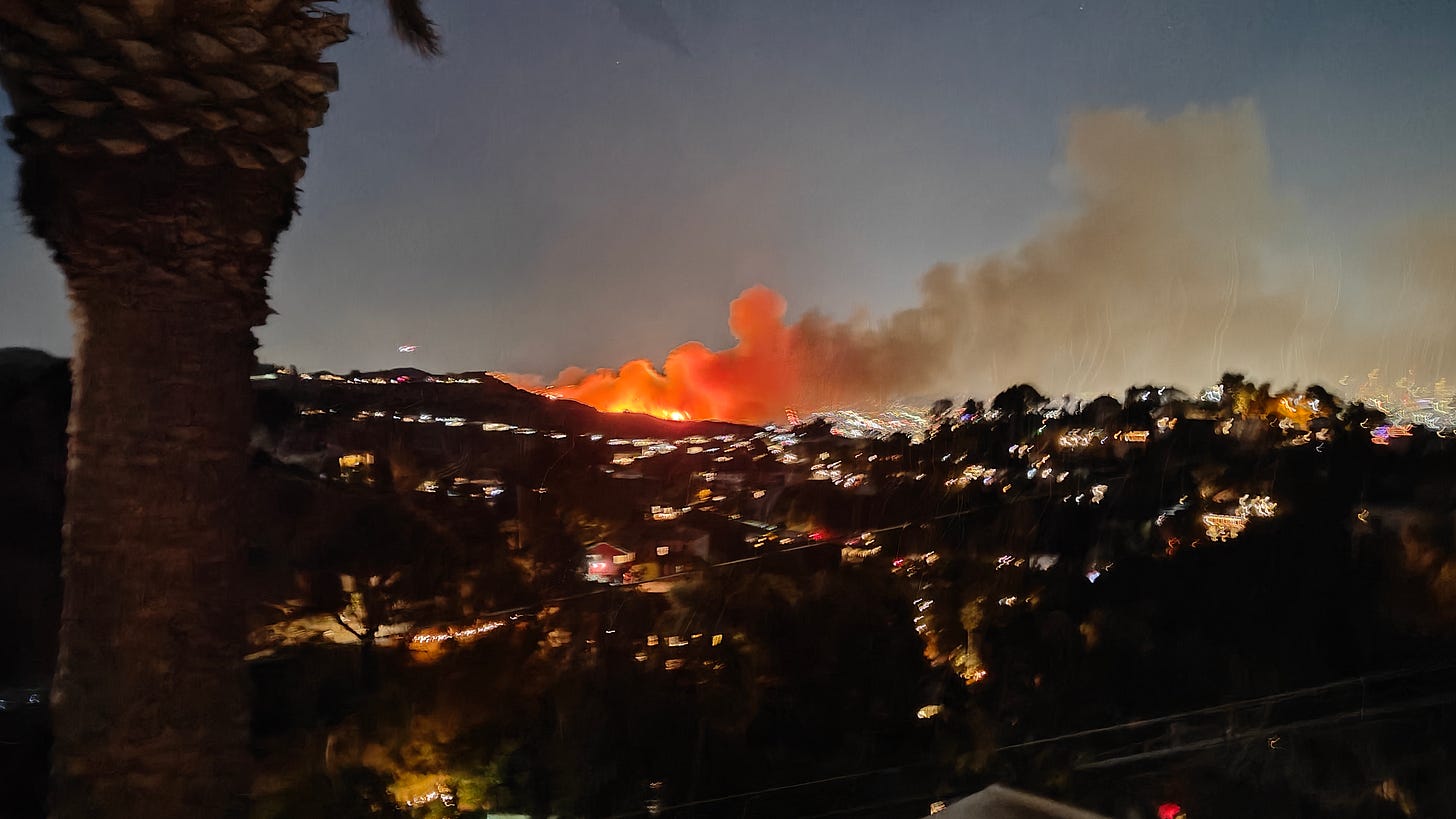The Fire This Time
"I reached inside myself and found / Nothing there to ease the pressure / Off my ever-worrying mind," The Sun Always Shines on TV (a-ha, Pål Waaktaar, 1985).

Seven days in, swaths of Los Angeles remain a fireground, the City and County a disconsolate metropolis consumed by smoke and flames, battered as well by a collapsing entertainment industry, awash in homelessness, poverty and inequality, ineffectively served by state and local leadership, and aghast at an incoming president expected to be heartless, fascist and antithetical to most Angelenos’ values, likely indifferent to the City’s plight, and still avowedly in denial of the human-caused climate change that likely drives ever more frequent and ferocious firestorms.
Thousands of structures have burned, a hundred thousand people are displaced, at least 25 are dead, and wealthy stars, visionary writers and artists, and middle- and working-class residents of all stripes are now overwhelmed, dumbfounded and homeless thanks to wildfires driven by fierce Santa Anas. Raymond Chandler (Red Wind) and Joan Didion (The Santa Anas) notably wrote about these desert winds, and now the city remains in a crushing nexus of potential gale-force blasts, low humidity and dry tinder, an ocean-side Gotham perilously situated at the wildland-urban interface.
Postmortems will ask, too, whether allegedly feckless state and local leaders share blame, a question as old as the water wars depicted in Chinatown. And those in and around entertainment already face devastating unemployment that began in the wake of Covid, the streaming wars and 2023’s labor strikes, and that will likely get worse.
But as sadly historic as the latest wildfires are, as lengthy and arduous the recovery ahead, and as bleak as today’s darkness at noon, the pain cannot prevail and destruction will not triumph: as with the City’s serial ravages of the early 1990s, Los Angeles will rise from ruination again — not just because it must, but because America needs Los Angeles and the world needs America.
“All my powers waste away
I fear the crazed and lonely looks
The mirror’s sending me these days”
— The Sun Always Shines on TV
We’ve been here before. When I moved to Los Angeles in 1991 to seek my piece of the dream, I was so besotted that a colleague’s upcoming vacation momentarily baffled me: Where could you possibly go? I thought. You’re already here. A native Northeasterner, I found something new at every turn, even asking what Cyn meant on the street signs off the beguiling PCH.
But within months came the 1992 LA Riots, curfew, wildfires, mudslides, the 1994 Northridge quake, the hollowing out of the local economy as aerospace, banking and petroleum departed, the ascendancy of Silicon Valley at LA’s expense, recession and joblessness. The high-profile acquittal of OJ Simpson. The anti-immigrant Proposition 187. The continuing AIDS crisis. Later times saw escalating rents, housing prices and homelessness.
Soon, locals were asking me in astonishment, “You moved to Los Angeles?” And, my early days in Los Angeles were tough times for me personally and professionally, as early days are for many, especially the city’s creative class.
I hear 'em every day
The rhythms in the canyons
That'll never fade away
— Another Day of Sun (La La Land,
Benj Pasek and Justin Paul, 2016)
But through all the hardship and turmoil, I never stopped California dreamin’, and I came to see life as a quantum glass: not one that’s either half full or half empty, but one that is at once three-quarters full and three-quarters empty. Only science or faith can conceive a glass overflowing with joy and gloom concurrently, like the hypothetical Schrödinger’s cat, simultaneously dead and alive. And like monarchs of old — “The king is dead, long live the king!” — Los Angeles will persist and revive.
As it must, because across red states and blue, even a battered Hollywood and a riven Los Angeles represent hope. Without hope, despair stalks at will — and, indeed, so-called “deaths of despair” are sharply up across much of the country, a crisis of hopelessness (as is MAGA).
You may imagine that the battles we fight are in the streets, the statehouses and gun-infested schools; or online; or at distant war zones; or in Washington; and, right now, in Pacific Palisades, Altadena and elsewhere as courageous firefighters plunge into infernos or smoldering wildlands. All this is true. But in an era of infinite media and pervasive smartphones, the real battlefield is people’s brains, and the struggle for hearts and minds can tip in any direction. Hate and violence feed on despair. That’s why hope is essential for survival.
And not only do Los Angeles and California, however flawed, represent and embody hope to millions of Americans, so too does America to billions of people around the world, notwithstanding the country’s tragic shortfalls. Our military complex, the intelligence community, our industrial base, sheer size and economy are the envy of the world and more powerful than any other — vastly so in most cases. Yet the American dream — our personal and economic freedoms, the beacon of hope that is this nation — is more powerful still, and leaders who deprecate its puissance risk us grievous harm.
But hope without action is meaningless (or worse, argues Hannah Arendt), yet action without hope soon peters out or runs aground. We need a Harden Los Angeles initiative that will future proof the city. What’s happened is intolerable and must never occur again. Technological measures, building codes, budgets, the City’s balkanized and leaden governance structure (and the County’s too) — everything must be up for review and revision to ensure that the next wildfire, or earthquake, flood or mudslide, does not again destroy vital neighborhoods of Southern California.
For Hollywood, for Los Angeles, and for the United States there is no alternative to rebuilding, better and stronger, and no substitute for hope. The sun always shines on TV, and so it must in our hearts.



